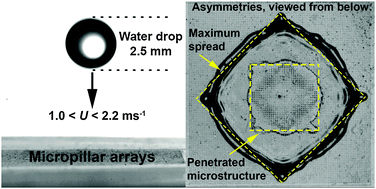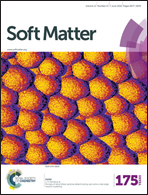Asymmetries in the spread of drops impacting on hydrophobic micropillar arrays†
Abstract
Studies of water drop impacts on microstructured surfaces are important for understanding dynamic wetting on rough surfaces, and for developing related design principles. Here, high-speed imaging has been used to study asymmetries within the spreading phase following vertical water drop impacts at Weber numbers between 34 and 167. The eleven polydimethylsiloxane surfaces studied had micropillars arranged in square and rectangular arrays, with feature sizes ranging from ∼5 μm to ∼240 μm and various pillar cross-sections, in most cases supporting a static Cassie state. Two contrasting and apparently independent asymmetries were identified. Firstly, partial (rather than full) microstructure penetration occurred on five of the surfaces, with the edges of the penetrated profiles tending to lie parallel to the array rows and columns. These observations are best explained by considering surface energies. Secondly, the perimeter of a spreading drop tends to lie at 45° to the rows and columns. This shape is caused by movement of air from underneath the impacting drop, which generates jets and subsequent fingers in preferred directions at the edge of the drop. The area of the ‘corridor’ through which the air escapes is an important quantitative parameter. Experiments also demonstrate the effects of microstructures on the maximum spreading diameter, and formation of off-centre microbubble patterns.


 Please wait while we load your content...
Please wait while we load your content...